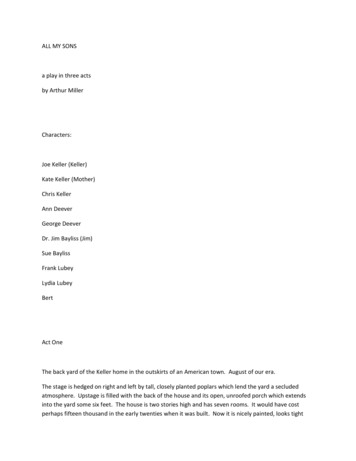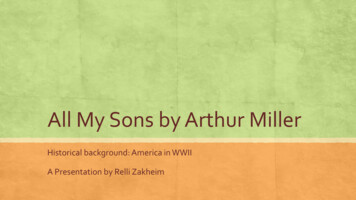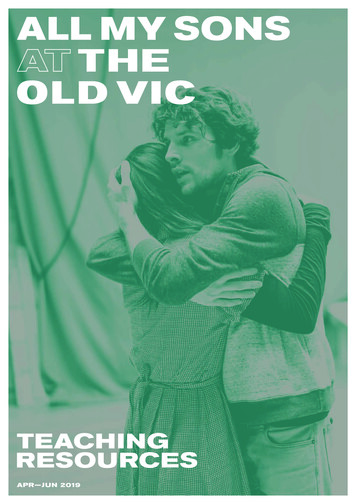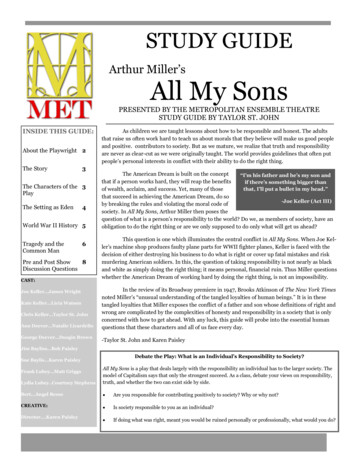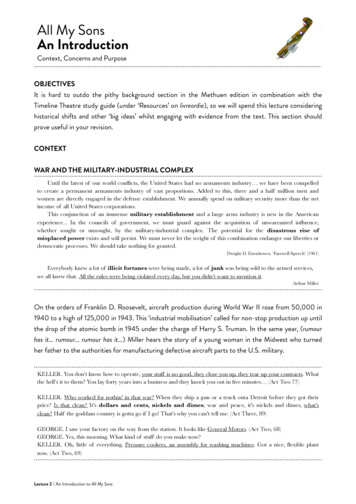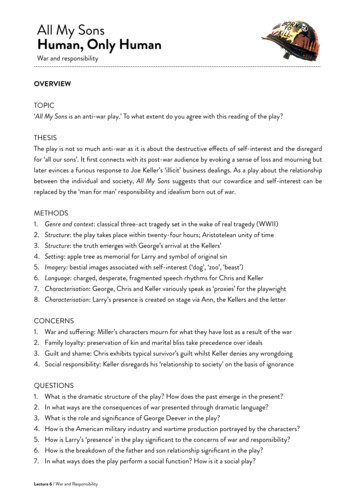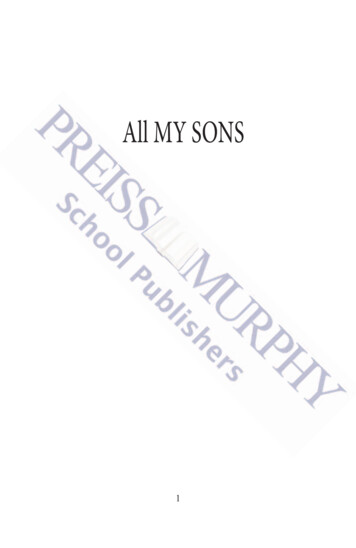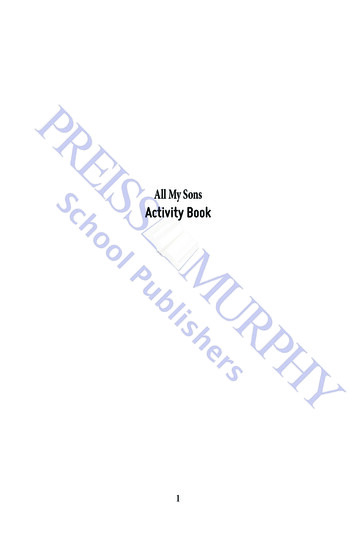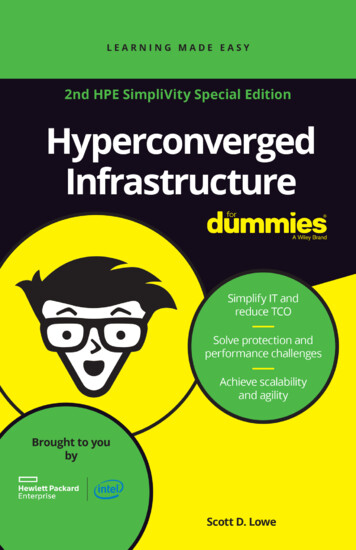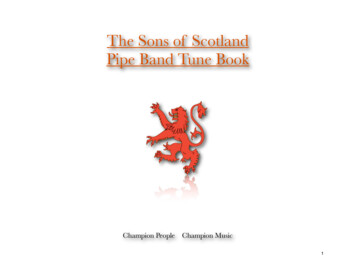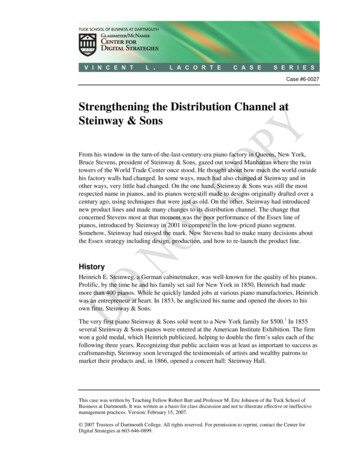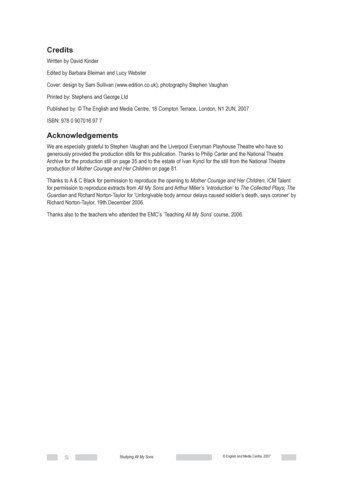
Transcription
CreditsWritten by David KinderEdited by Barbara Bleiman and Lucy WebsterCover: design by Sam Sullivan (www.edition.co.uk); photography Stephen VaughanPrinted by: Stephens and George LtdPublished by: The English and Media Centre, 18 Compton Terrace, London, N1 2UN, 2007ISBN: 978 0 907016 97 7AcknowledgementsWe are especially grateful to Stephen Vaughan and the Liverpool Everyman Playhouse Theatre who have sogenerously provided the production stills for this publication. Thanks to Philip Carter and the National TheatreArchive for the production still on page 35 and to the estate of Ivan Kyncl for the still from the National Theatreproduction of Mother Courage and Her Children on page 81.Thanks to A & C Black for permission to reproduce the opening to Mother Courage and Her Children; ICM Talentfor permission to reproduce extracts from All My Sons and Arthur Miller’s ‘Introduction’ to The Collected Plays; TheGuardian and Richard Norton-Taylor for ‘Unforgivable body armour delays caused soldier’s death, says coroner’ byRichard Norton-Taylor, 19th December 2006.Thanks also to the teachers who attended the EMC’s ‘Teaching All My Sons’ course, 2006.2All My Sons 23.01.07.indd 2Studying All My Sons English and Media Centre, 200723/1/07 10:01:21
ContentsContentsIntroductionBefore readingReading the playAfter readingTeachers’ notes English and Media Centre, 2007All My Sons 23.01.07.indd 3Reading the play4A group approach to reading5Miller’s drama – conflicts and challenges9The context10Reading fragments11, 12-13What is All My Sons about? A critic’s view111. Opening stage direction142. Keller and the neighbours163. The introduction of Chris194. The introduction of Mother235. The introduction of Ann246. Gradual revelations277. ‘A kind of – responsibility’298. ‘The boy is coming’309. ‘A father is a father!’3410. The arrival of George3611. The truth revealed3712. The conclusion of Act 23913. ‘A forty foot front’4214. The end of the play44Miller’s themes47Symbols and motifs47Exploring All My Sons in context48Miller’s views on All My Sons and writing plays51Why All My Sons?55What’s in a name?55Exploring Miller’s stage directions57Exploring the subtext of All My Sons60A linguistic approach to Miller’s dialogue63The moral aspect of All My Sons65Character studies – Chris and Mother66Who is the central character?73The key line74Critical soundbites75Exploring Miller’s choice of form – comparing openings76Tragedy82Ibsenism and the ‘well-made’ play86A ‘well-made’ play – Miller’s use of the 3 act structure87Exploring proxemics88Answers and annotated examples95Studying All My Sons323/1/07 10:01:21
IntroductionIntroductionReading the playAll My Sons is short enough to be read aloud in its entirety in only a couple of lessons. You may decide to read theplay straight through the first time in order to give students the opportunity to experience Miller’s control of tensionand to maintain a sense of the play as theatre. On the other hand, you may find it useful to pause at several keymoments in the drama to reflect on, for example, the presentation of character, the themes and moral issues beingexplored, and Miller’s development and control of the tension. The following approaches to reading and studyingthe play would all work well.1. A quick read-through, followed by slower, more analytical study, using a selection of activitiesprovided in this resource.2. A quick-read through, pausing at a few key moments (suggestions i-vii below), followed by fulleractivities.i.Before reading activities (see pages 9-13).ii. Pause at the end of ‘Now stop it!’ to discuss the development of tension and drama (see page 23).iii. At the end of ‘Section 6 – Gradual revelations’, choose a key line and collect together themeswhich seem to be emerging (see page 27).iv. At the end of Act 1, use the open questions on page 32 in class discussion to share understandingof, and response to, the first act.v. After ‘Section 11 – The truth revealed’, discuss:–the revelation–the characters and their reaction to the revelation–the themes, issues and ideas explored and dramatised by Miller–the dramaturgy and structure of the play.vi. End of Act 2: predict the end of the play, with reasons why. This could be tackled as a dramaactivity, with students in groups, improvising their ending.vii. End of Act 3: a response chain as explained on page 44 and a series of tableaux (between threeand six still pictures) to represent the key points in the play.3.4All My Sons 23.01.07.indd 4A stage-by-stage read-through, incorporating detailed study into the reading.Studying All My Sons English and Media Centre, 200723/1/07 10:01:22
IntroductionA group approach to readingFor the purposes of close analysis, this resource divides All My Sons into 14 roughly equal ‘sections’, with activitiesrelating to each segment.The tables below and on pages 6-8, provide a way of dividing each of the 14 main sections into further subsections (referred to as ‘passages’ throughout this material) suitable for preparation and performance by smallgroups. You may decide to use this approach throughout the reading of the play or to draw on it at points whereyou think experiencing the play as drama is particularly important. Before beginning to prepare their passage eachstudent should have read the whole of the section. This could be done in students’ own time for homework. Thetables indicate the number of speaking parts in each passage; if there are more students in the class than there arespeaking parts, it is always useful to have observers to comment on the interpretation of the play being suggestedin the performance. The reading itself can be done in many ways, for example rehearsed readings, edited versions,specific drama activities or just reading in groups.Section 1 – The opening stage directionThis is a short section which could be read and discussed as a class or in small groups.Section 2 – The introduction of Keller and the neighboursFrom Jim: ‘Where’s your tobacco?’ to Lydia: ‘Sh! sh!’ [She exits, laughing].Group AGroup BGroup CGroup DGroup EFrom Jim: ‘Where’s yourtobacco?’ to Jim: [Softly,with wonder, as he scansthe page] ‘Psss!’From Frank: [Noticingthe tree] ‘Hey, whathappened to your tree?’to Frank: ‘I didn’t evensee you.’From Keller: ‘Is hetalkin’ sense?’ to Jim: ‘.there’s not a damn thingto look at.’From the stagedirection [Sue, Jim’swife enters] to Sue:[laughing, pointing athim] ‘Now you said it!’From the stagedirection [Lydia Lubeyenters] to Lydia: ‘Sh! sh!’[She exits, laughing].Keller, Jim, FrankKeller, Frank (Jim nonspeaking)Keller, Jim, FrankKeller, Jim, SueKeller, Lydia, Frank, SueSection 3 – The introduction of ChrisFrom [Chris watches her off. He is thirty-two] to Keller: ‘Yeah. I can see that.’Group AGroup BGroup CGroup DGroup EFrom the stagedirection [Chriswatches her off] to[Keller chuckles andwinks at Chris, who isenjoying all this].From Keller: ‘Yeah,that’s a dangerouscharacter, that Tommy’ toChris: ‘No, I – I figuredthe best thing was toleave her alone.’ [Pause]From Keller: [deeplytouched] ‘She criedhard?’ to Chris: ‘I’mgoing to ask her to marryme.’ [Slight pause]From Keller: ‘Well, that’sonly your business,Chris.’ to Chris: ‘Do youknow? I don’t!’ [Pause]From Chris: ‘All right,then, Dad.’ to Keller:‘Yeah. I can see that.’Keller, Chris, BertKeller, Chris, BertKeller, ChrisKeller, ChrisKeller, ChrisSection 4 – The introduction of MotherFrom stage direction [Mother appears on porch] to the end of Mother’s speech: ‘Now stop it!’Group AGroup BGroup CGroup DFrom the stagedirection [Motherappears on porch] to [Hesits in one of the chairs].From the stagedirection [Mothercomes out on last line] toChris: ‘Can I get you anaspirin?’From the stagedirection [Mother putsher hand to her head]to [He goes up into thehouse with new spirit.Her smile vanishes].From the end ofFrom Mother: [With anMother’s speech: [Sheaccusing undertone] toMother: ‘Look at it; look.’ sits on bench.] ‘Joe –’ toend of Mother’s speech:‘Now stop it!’Keller, Chris, MotherKeller, Chris, MotherKeller, Chris, MotherKeller, Mother English and Media Centre, 2007All My Sons 23.01.07.indd 5Studying All My SonsGroup EKeller, Mother, Bert523/1/07 10:01:22
IntroductionSection 5 – The introduction of AnnFrom stage direction [As Ann and Chris appear on porch] to Mother’s line: ‘I have to have some tea.’Group AGroup BGroup CGroup DGroup EFrom the stagedirection [As Ann andChris appear on porch]to Ann: ‘Oh, excuse me!’From the stagedirection [Jim hascome to fence and islooking over it] to Ann:‘That’s a funny thing tosay; how could I helpremembering him?’From Mother: [– it isdrawing to a head thewrong way for her] to thestage direction [Theyare laughing].From the stagedirection [Ann takespan of beans off stool] toChris: ‘Yes, I am.’From Mother: ‘Well ifyou’re sure then you’resure.’ to Mother: ‘I haveto have some tea.’Keller, Chris, Mother,Ann, Sue (as voiceoff-stage)Jim, Chris, Ann, Mother,Sue (voice off-stage),(Keller non-speaking)Keller, Chris, Mother,AnnChris, Mother, Ann,(Keller non-speaking)Chris, Mother, Ann,(Keller non-speaking)Section 6 – Gradual revelationsFrom the stage direction [Frank appears, carrying ladder] to the stage direction [He exits, laughing, into house].Group AGroup BGroup CGroup DFrom the stagedirection [Frankappears, carrying ladder]to the stage direction[Ann rises and comes toKeller].From Ann: [wondrouslyat them, happy] ‘Gosh,it’s wonderful to hearyou’ to the end ofKeller’s speech: ‘Youhear me?’From Ann: [surprised]‘Don’t you hold anythingagainst him?’ to thestage direction [Motherturns and goes intohouse].From the end of Keller’sspeech: ‘Now look,Annie.’ to the stagedirection [He exits,laughing, into house].Keller, Chris, Mother,Ann, FrankKeller, Chris, Mother,AnnKeller, Chris, Mother,AnnChris, Ann, KellerSection 7 – ‘A kind of – responsibility’From Chris: [calling after him] ‘Drink your tea, Casanova.’ to the stage direction [They kiss. Keller enters from thehouse].The whole of this section is a conversation between Ann and Chris. It is unusual in the play both because of itsextended nature and because there is no on-stage audience for it.Rather than groups working on different, consecutive extracts from the passage, students could prepare theconversation in pairs, before performing one or two versions to the class. It would be interesting to begin theanalysis of this section with a discussion of the range of ways it is possible to play the two characters in thisextended, intimate conversation.Section 8 – ‘The boy is coming’From Keller: [thumbing towards the house] ‘Hey, Ann, your brother’ – to the end of Act 1.Group AGroup BGroup CGroup DGroup EFrom Keller: [thumbingtowards the house] ‘Hey,Ann, your brother –’ tothe stage directionduring Chris’s speech[With misgivings, Anngoes up and into house].From half way throughChris’s speech: ‘We’regetting married, Dad’ toKeller: [breaking in] ‘Allright, forget it, forget it.’From the stagedirection in Keller’sspeech [With great force,moving about] to theend of Keller’s speech:‘Champagne, tuxedos –’From the stagedirection [He breaks offas Ann’s voice comesout loud from the house]to Ann: [as she andChris exit up driveway]‘See you.’From the stagedirection [Mother comesdown towards Keller, hereyes fixed on him] to theend of Act 1.Keller, Ann, ChrisKeller, Ann, ChrisKeller, ChrisKeller, Ann, Chris,MotherKeller, Mother6All My Sons 23.01.07.indd 6Studying All My Sons English and Media Centre, 200723/1/07 10:01:23
IntroductionSection 9 – ‘A father is a father’From the beginning of Act 2 to the end of Keller’s ‘song’: ‘Oh, come on up, come on up, and come my lady’s hair –’Group AGroup BFrom the beginningof Act 2 to the end ofChris’s line: ‘Let meknow when Georgegets here.’From the stagedirection [Hegoes into thehouse] to the endof Ann’s speech:‘It’s something veryimportant to me.’Chris, Mother, AnnSue, AnnGroup CGroup DGroup EGroup FFrom Ann:‘Certainly, if I can doit.’ to end of Sue’sspeech: ‘I’m at theend of my rope on it!’From the stagedirection [Chrisenters on porch,wearing shirt and tienow] to the stagedirection [Theyembrace as Kellerappears on porch]From the end ofstage direction[Ann simply studieshim] to Keller’s line:‘No, a partner. Agood job.’From the stagedirection [Pause.He sees she’sshocked, a littlemystified] to the endof Keller’s ‘song’:‘Oh, come on up,come on up, andcome my lady’shair –’Sue, AnnChris, Sue, AnnChris, Sue, AnnChris, Keller, Ann,LydiaSection 10 – The arrival of GeorgeFrom the stage direction [Jim Bayliss rounds corner of driveway, walking rapidly] to the end of Ann’s speech:[She hears footsteps.] ‘Shsh!’Group AGroup BGroup CGroup DFrom the stagedirection [Jim Baylissrounds corner ofdriveway, walkingrapidly] to Jim and Sue’sexit.From Chris [calling afterthem] to Ann: [quickly,to forestall an outburst]Sit down, dear. Don’t beangry, what’s the matter?From the stagedirection [He allows herto seat him, looking ather] to the end of Ann’sspeech: ‘You know howquick he can lie.’From George: [turning toChris, with deliberation]‘I’ll ask you something.’to the end of Ann’sspeech: [She hearsfootsteps] ‘Shsh!’Chris, Sue, Jim, George,AnnAnn, Chris, GeorgeAnn, Chris, GeorgeAnn, Chris, GeorgeSection 11 – The truth revealedFrom the stage direction [Mother enters on porch] to the end of George’s speech: ‘What happened that day,Joe?’Group AGroup BGroup CGroup DGroup EFrom the stagedirection [Mother enterson porch] to end ofMother’s speech: ‘Thewind came along and –’From the stagedirection [Lydia enterson porch] to Mother:[as a reprimand] ‘She’sbeautiful, you damnedfool!’From George: [looksaround longingly] toMother: [to George] ‘Henever shot anybody.’From the stagedirection [They all burstout laughing] to Keller:‘Then remember them,remember them.’From the stagedirection [Ann comesout of house] to George:‘What happened thatday, Joe?’George, Chris, Mother,AnnGeorge, Chris, Mother,Ann, LydiaKeller, George, Chris,Mother, Ann (one line)Keller, George, Chris,MotherKelle
All My Sons is short enough to be read aloud in its entirety in only a couple of lessons. You may decide to read the play straight through the first time in order to give students the opportunity to experience Miller’s control of tension and to maintain a sense of the play as theatre. On the other hand, you may find it useful to pause at several key moments in the drama to reflect on, for .
